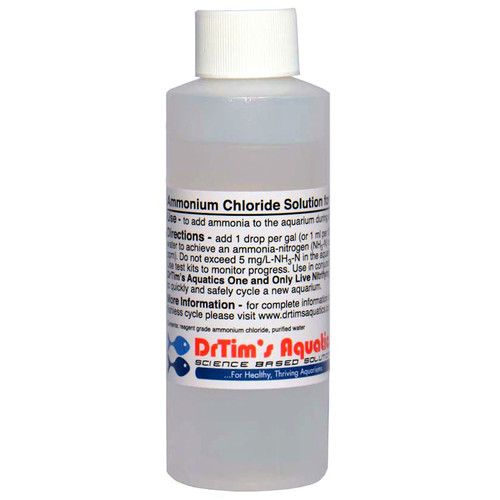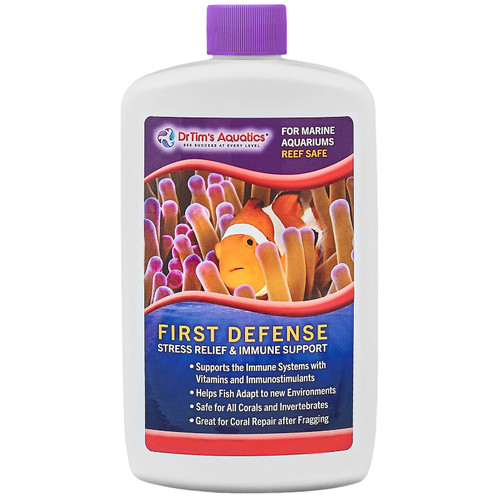DrTim's Aquatics Ammonium Chloride, 4oz.
Ammonia for fishless cycling
One of our most popular products is our Ammonium Chloride for fishless cycling. As the term implies fishless cycling means without fish but there needs to be a source of ammonia for the nitrifying bacteria. That�s why we provide ammonium chloride drops � for you to use to feed the nitrifying bacteria that come in our One & Only Live Nitrifying Bacteria.
But there is some confusion about whether to use 1 drop per gallon or 4 drops per gallon. The confusion stems from the fact that when we first started selling the product the instructions were to use 1 drop per gallon. Several years ago we changed that to 4 drops per gallon. However, there are still references (and some old bottles available) saying to use 1 drop per gallon.
1 drop or 4: What to do?
So what�s the right answer � do you use 1 drop of 4 drops per gallon?
If you have a bottle that says use 1 drop per gallon � do that.
If you have a bottle that says use 4 drops per gallon � do that.
In either case the most important thing to do is follow our primary instructions of not adding more ammonia drops if EITHER ammonia or nitrite is above 5 mg/L.
For more details you can download our recipe to fishless cycling here.
What Units are you measuring in?
So you used 1 drop or 4 drops and you measured ammonia (or nitrite) and the values are higher than the �target; of 2 mg/L. What�s wrong? First, don�t worry too much about being exactly at 2. As long as you are below 5 mg/L you�re ok. But 5 mg/L what? There are no units after the 5 mg/L!! And this is another source of confusion. Test kits measure in different units � some measure in ions units others measure in the nitrogen base. What is that and how can you tell the difference? If the test kit has something like 2 mg/L NH3-N the �-N� means the units are nitrogen based and the results are recorded as 2 mg/L ammonia-nitrogen. If the kits has 2 mg/L NH4+ then most likely the results are recorded as 2 mg/L ammonium ion. Both can be correct � it is like measuring in inches or centimeters � both are correct you just have to make sure you note which one you are using.
That said there is difference in the numbers. Staying with our analogy 1 inch equals 2.5 centimeters. If you are not reporting the units some reads might assume inches when you mean centimeters and think you mean 2.5 inches instead of 2.5 centimeters. The table below gives you the differences in unit:
1 mg/L ammonia-nitrogen = 1.216 mg/L ammonia ion = 1.358 mg/L ammonium ion.
1 mg/L nitrite-nitrogen = 3.284 mg/L nitrite ion
1 mg/L nitrate-nitrogen = 4.427 mg/L nitrate ion.
If you follow our directions and shot for 2 mg/L ammonia-nitrogen some test kits would read 2.4 to 2.7 depending not the whether they use the ammonia or ammonium ion.
Further, since the bacteria convert at a 1 to 1 ratio that 2 mg/L ammonia-nitrogen will convert to 2 mg/L nitrite-nitrogen which will convert to 2 mg/L nitrate-nitrogen. But if you are using some popular test kits that report as the ion form that 2 mg/L ammonia-nitrogen will start out as 2.7 ammonium ion turning to 6.6 nitrite ion becoming 8.9 nitrate ion.
The point here is to know the units of your test kit!
No chlorine
Another thing to know is that you are NOT adding chlorine to the water when you are adding ammonium chloride. There has been a increased number of questions to us asking what to do about the �chlorine� one is adding to the tank when using our ammonium chloride drops. Chloride is not the same as chlorine and chloride does not become chlorine when you add the drops. Not sure where this idea had come from but it not correct.
Some conversions regards drops of our ammonium chloride:
1 ounce equals about 30 ml which equals 600 drops.
1 tablespoon equals about 15 ml which equals 300 drops.
1 teaspoon equals about 5 ml which equals 100 drops.
Good fish keeping!
Item No. AD-DT115















